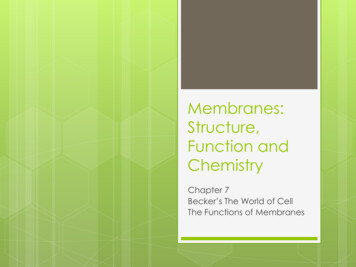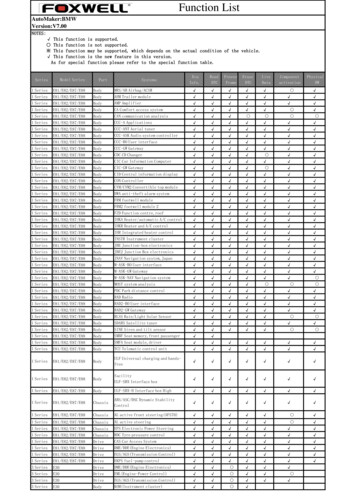
Transcription
Membranes:Structure,Function andChemistryChapter 7Becker’s The World of CellThe Functions of Membranes
Cellshave a variety of membranes thatdefine the boundaries of the cell and itsinternal compartments. All biologicalmembranes have the same generalstructure: a fluid phospholipid bilayercontaining a mosaic of embeddedproteins.
While the lipid component of membranesprovides a permeability barrier, specificproteins in the membrane regulatetransport of materials into and out of cellsand organelles.
Membranesserve as sites for specificproteins and thus can have specificfunctions. They can detect and transduceexternal signals, mediate contact andadhesion between neighboring cells, orparticipate in cell-to-cell communication.They also help to produce externalstructures such as the cell wall orextracellular matrix.
Models of MembraneStructure: AnExperimentalPerspective
Ourcurrent understanding of membranestructure represents the culmination ofmore than a century of studies, beginningwith the recognition that lipids are animportant membrane component.
Onceproteins were recognized asimportant components, Davson andDanielli proposed their “sandwich”model—a lipid bilayer surrounded on bothsides by layers of proteins. As membranesand membrane proteins were examinedin more detail, however, this model waseventually discredited.
In place of the sandwich model, Singerand Nicolson’s fluid mosaic modelemerged and is now the universallyaccepted description of membranestructure. According to this model,proteins with varying affinities for thehydrophobic membrane interior float inand on a fluid lipid bilayer.
We now know that lipids and proteinsare not distributed randomly in themembrane but are often found inmicrodomains known as lipid rafts that areinvolved in cell signaling and otherinteractions.
Membrane Lipids: The “Fluid”Part of the Model Prominentlipids in most membranesinclude numerous types of phospholipidsand glycolipids. The proportion of eachlipid type can vary considerablydepending on the particular membraneor monolayer.
Ineukaryotic cells, sterols are alsoimportant membrane components,including cholesterol in animal cells andphytosterols in plant cells. Sterols are notfound in the membranes of mostprokaryotes, but some bacterial speciescontain similar compounds calledhopanoids.
Properfluidity of a membrane is critical toits function. Cells often can vary thefluidity of membranes by changing thelength and degree of saturation of thefatty acid chains of the membrane lipidsor by the addition of cholesterol or othersterols.
Long-chainfatty acids pack together welland decrease fluidity. Unsaturated fattyacids contain cis double bonds thatinterfere with packing and increasefluidity.
Mostmembrane phospholipids andproteins are free to move within the planeof the membrane unless they arespecifically anchored to structures on theinner or outer membrane surface.Transverse diffusion, or “flip-flop,”between monolayers is not generallypossible, except for phospholipids whencatalyzed by enzymes calledphospholipid translocators, or flippases.
As a result, most membranes arecharacterized by an asymmetricdistribution of lipids between the twomonolayers and an asymmetricorientation of proteins within themembranes so that the two sides of themembrane are structurally andfunctionally dissimilar.
Membrane Proteins: The “Mosaic”Part of the Model Proteinsare major components ofall cellular membranes. Membraneproteins are classified as integral,peripheral, or lipid anchored, basedon how they are associated withthe lipid bilayer.
Proteinsare major components ofall cellular membranes. Membraneproteins are classified as integral,peripheral, or lipid anchored, basedon how they are associated withthe lipid bilayer.
Integral membrane proteins have one ormore short segments of predominantlyhydrophobic amino acids that anchor theprotein to the membrane. Most of thesetransmembrane segments are a-helicalsequences of about 20–30 predominantlyhydrophobic amino acids.
Peripheralmembrane proteins arehydrophilic and remain on the membranesurface. They are typically attached tothe polar head groups of phospholipidsby ionic and hydrogen bonding.
Lipid-anchoredproteins are alsohydrophilic in nature but arecovalently linked to the membraneby any of several lipid anchors thatare embedded in the lipid bilayer.
Membrane proteins function as enzymes, electroncarriers, transport molecules, and receptor sites forchemical signals such as neurotransmitters andhormones. Membrane proteins also stabilize and shapethe membrane and mediate intercellularcommunication and cell-cell adhesion.
Manyproteins in the plasmamembrane are glycoproteins, withcarbohydrate side chains thatprotrude from the membrane onthe external side, where they playimportant roles as recognitionmarkers on the cell surface.
Thanks to current advances in SDS-PAGE, molecularbiology X-ray crystallography, affinity labeling, and theuse of specific antibodies, we are learning much aboutthe structure and function of membrane proteins thatwere difficult to study in the recent past.
Becker's The World of Cell The Functions of Membranes . participate in cell-to-cell communication. They also help to produce external structures such as the cell wall or extracellular matrix. Models of Membrane Structure:










